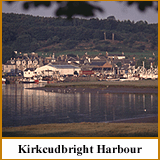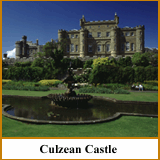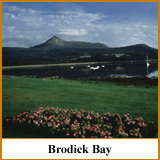

 |
 |
|
|
|
|
South
of Scotland
| West Highlands & Islands, Loch
Lomond, Stirling & Trossachs |
Perthshire, Angus & Dundee and Kingdom of Fife | The
Highlands of Scotland | Grampian
Highlands, Aberdeen & North East Coast | The
Outer Islands - Orkney, Shetland and Western Isles | Edinburgh
- City, Coast and Countryside | Greater
Glasgow & Clyde Valley
|
|||
|
SOUTH
OF SCOTLAND |
||||
| Rich rolling farmland, rugged seacoasts and Clyde coast islands characterise the South of Scotland. Robert Burns and Sir Walter Scott both lived in this land of ancient abbeys, castles and historic houses. | ||||
|
Then there are the forests and wild moors of upland Galloway and the vivid greens of Ayrshire's pastures, with the mountain profile of the island of Arran as a backdrop. Wherever you travel here, you can be assured of a real Scottish welcome. DUMFRIES AND GALLOWAY Lonely hills roll down to pastures and dark woods and in turn, give way to rich farmlands and a sunny south facing coastline. Scotland's southwest is blessed with a mild climate and offers plenty to entertain the visitor from beautifully photogenic gardens and villages to dramatic castles reached by quiet roads. The main town of Dumfries is an important local centre with places to visit associated with Robert Burns, Scotland's national poet. Other towns are small and show the typical Galloway layout of painted pastel colours on pretty houses along wide main streets.
North of Dumfries, Ellisland Farm is associated with Robert Burns. The farm has now been restored to what it would have looked like at the time of Burns. The poet wrote many famous works while farming here with his young wife Jean Armour, a theme taken up by the on-site audiovisual.
THE SCOTTISH BORDERS The Scottish Borders, less than an hour's drive from Edinburgh, is an area of tranquil villages, bustling textile towns and varied scenery. Visitors can enjoy a wide range of attractions, including many magnificent historic houses, great Border Abbeys, which tell their own tale of Border feuds with England, and working woolen mills and craft workshops. The daring adventures of the old time reivers (Border raiders) are still recounted in song and ballad today. Drumlanrig's Tower in Hawick, the largest of the Scottish Border towns, portrays life in bygone days. The spirit of self-reliance and pride in the community is nowhere better expressed than in the Border Common Ridings. These annual events in early summer recall times when community boundaries had to be protected from invaders. Now they are great celebrations of horsemanship. The town of Selkirk claims that its Common Riding is the largest mounted gathering anywhere in Europe. Sir Walter Scott, the famous Scottish writer, lived at Abbotsford near Melrose. Visit his house today to see his collection of memorabilia from Scotland's story. Scott is buried at Dryburgh Abbey, one of four abbeys, which once were influential in Borders' life. The abbeys themselves were destroyed in 1544 by the invading armies of the English King Henry VIII, when Mary, Queen of Scots was but a young child. Today, the ruins stand as a beautiful and poignant reminder of times past. A major visitor centre at Jedburgh Abbey explains the abbey's former importance. The monks first developed the skill of working with wool, laying the foundation of the textile industry, which still thrives in the area today. Lochcarron of Scotland in Galashiels is just one of the many textile mills and shops where visitors can see the manufacturing processes and purchase the finished goods. The Romans also passed this way. They named their main camp Trimontium, as it lay below the triple peaked Eildon Hills near Melrose. The Trimontium Exhibition in this handsome little town tells the story of Roman occupation. Melrose also has many other features to detain you, including an abbey and teddy bear museum. Another special characteristic is the choice of grand homes and castles to visit. Manderston, near Duns, is often described as the most magnificent Edwardian house in Scotland. Floors Castle, on the edge of Kelso, is said to be the largest inhabited home in Scotland. Traquair House near Innerleithen also has its own distinctive feature, as the oldest continually inhabited house in Scotland. Many of these properties have fine gardens, which is another Scottish Borders' trait. Other gardens to visit include Dawyk, west of Peebles, an outstation of Edinburgh's Royal Botanic Garden and Priorwood, beside Melrose Abbey. AYRSHIRE AND THE ISLE OF ARRAN In Ayrshire and the Isle of Arran, one can enjoy the contrasts between island and mainland life whilst exploring the many visitor attractions. These include historic castles, country parks and 44 golf courses, which include world-famous Royal Troon, Turnberry and Prestwick. There is also superb walking amid the forests and mountains of Arran (the main peak, Goat Fell, is the highest point in the South of Scotland), award-winning museums and heritage centres. Ayrshire is the land of Robert Burns, Scotland's national poet. His birthplace, now Burns Cottage and Museum, at nearby Alloway, is within the Burns National Heritage Park where you can visit other Burns attractions. These include the Tam o' Shanter Experience, an exciting audiovisual experience based on Burn's great comic narrative poem, which tells of farmer Tam o' Shanter's encounter with witches on the way home from a long evening in a local alehouse. Ayr is the starting point of the Burns Heritage Trail, which traces the life of the poet from his birthplace in Alloway south to Dumfries. Northwards, the story of Scotland's seafaring past is told in the Scottish Maritime Museum at Irvine. Inland, a major display of early musical instruments and armour can be seen at Kilmarnock's Dean Castle, a restored 14th century fortress. Also within easy reach, in the coastal town of Largs, is Vikingar, the Viking Heritage Centre. The Viking role in Scotland's story is explored through film, live actors and displays.
Because of its summer ferry service to Kintyre on the West Side, Arran makes an important stepping stone on any tour of the western seaboard. |
||||
|
 Kirkcudbright
has long attracted artists and you can visit Broughton House,
0 associated with the Scottish painter E.A. Hornel and also the Tolbooth
Arts Centre within the town. The ferry port of Stranraer is within
easy reach of Port Logan and Logan Botanic Gardens, where
Australasian tree ferns thrive in the mild air. Newton Stewart is the
gateway to the Galloway Forest Park, where lochs, woodland
and craggy hill slopes create grandeur and a wilderness experience to
match the Highlands further north. Nearby is Wigtown, the recently nominated
book town of Scotland.
Kirkcudbright
has long attracted artists and you can visit Broughton House,
0 associated with the Scottish painter E.A. Hornel and also the Tolbooth
Arts Centre within the town. The ferry port of Stranraer is within
easy reach of Port Logan and Logan Botanic Gardens, where
Australasian tree ferns thrive in the mild air. Newton Stewart is the
gateway to the Galloway Forest Park, where lochs, woodland
and craggy hill slopes create grandeur and a wilderness experience to
match the Highlands further north. Nearby is Wigtown, the recently nominated
book town of Scotland. Caerlaverock
and Threave Castles, Sweetheart and Dundrennan
Abbeys all tell of the antiquity of the Solway area. Whithorn
was the first Christian settlement in Scotland and was a place of pilgrimage
for generations of Scottish monarchs. An archaeological dig and associated
visitor centre portray the fascinating story. Part of the pilgrim route
is known as the Queen's Way (today's A712) and runs through some of the
area's finest landscapes in the Galloway Forest Park.
Caerlaverock
and Threave Castles, Sweetheart and Dundrennan
Abbeys all tell of the antiquity of the Solway area. Whithorn
was the first Christian settlement in Scotland and was a place of pilgrimage
for generations of Scottish monarchs. An archaeological dig and associated
visitor centre portray the fascinating story. Part of the pilgrim route
is known as the Queen's Way (today's A712) and runs through some of the
area's finest landscapes in the Galloway Forest Park. Culzean
Castle, the masterpiece of the architect Robert Adam, has an impressive
cliff-top setting and its spacious grounds form a country park. Children
can enjoy plenty of fun at other country parks, including the secret forest
at Kelburn Country Centre, an adventure and discovery trail
in the woodlands of the Kelburn Castle estate near Largs. From the estate,
there are views to the islands of Great Cumbrae and Little Cumbrae, with
the former, easily accessed from Largs, a real haven for cyclists.
Culzean
Castle, the masterpiece of the architect Robert Adam, has an impressive
cliff-top setting and its spacious grounds form a country park. Children
can enjoy plenty of fun at other country parks, including the secret forest
at Kelburn Country Centre, an adventure and discovery trail
in the woodlands of the Kelburn Castle estate near Largs. From the estate,
there are views to the islands of Great Cumbrae and Little Cumbrae, with
the former, easily accessed from Largs, a real haven for cyclists.  The
spectacular mountain profile of the Isle of Arran fills the sea horizon
as viewed from the Ayrshire coast. Playground for generations of outdoor
enthusiasts, Arran is easily reached by ferry from Ardrossan. In addition
to its adventurous walking, forest trails and coastal walks, the island
is also noted for the Isle of Arran Heritage Museum, as
well as prehistoric sites and standing stones. Brodick Castle and
Country Park is a major attraction - a magnificent castle built
over many centuries and displaying a very fine collection of art, porcelain
and silver. Outdoors, there are rare shrubs and plants and world-famous
rhododendron displays. Yet another attraction is the Isle of Arran
Distillers at Lochranza, a typical Scottish whisky distillery.
The
spectacular mountain profile of the Isle of Arran fills the sea horizon
as viewed from the Ayrshire coast. Playground for generations of outdoor
enthusiasts, Arran is easily reached by ferry from Ardrossan. In addition
to its adventurous walking, forest trails and coastal walks, the island
is also noted for the Isle of Arran Heritage Museum, as
well as prehistoric sites and standing stones. Brodick Castle and
Country Park is a major attraction - a magnificent castle built
over many centuries and displaying a very fine collection of art, porcelain
and silver. Outdoors, there are rare shrubs and plants and world-famous
rhododendron displays. Yet another attraction is the Isle of Arran
Distillers at Lochranza, a typical Scottish whisky distillery.